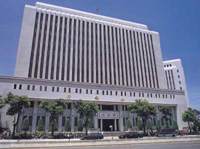 On February 21, 1923, Chinese National Father Dr. Sun Yat-sen assumed office in Kwangtung as Supreme Commander of the Army and Navy. Because the taxes levied were at that time completely under the control of the warlords, the supreme Commander's office was without funds of any sort, and so, in order to create a financial infrastructure, plans were made to establish a Central Bank. On August 15, 1924, the Central Bank was inaugurated in Kwangtung. On February 21, 1923, Chinese National Father Dr. Sun Yat-sen assumed office in Kwangtung as Supreme Commander of the Army and Navy. Because the taxes levied were at that time completely under the control of the warlords, the supreme Commander's office was without funds of any sort, and so, in order to create a financial infrastructure, plans were made to establish a Central Bank. On August 15, 1924, the Central Bank was inaugurated in Kwangtung.
On October 25, 1927, the Nationalist government formulated and promulgated the Statute of the Central Bank of China, which it subsequently revised on October 6 of the following year. The revised version of the statute made it clear that the Central Bank of China was the national bank. On November 1, 1928, the Central Bank of China formally commenced operations in Shanghai.
On May 23, 1935, the Nationalist government revised the Statute of the Central Bank of China, which became the Central Bank of China Act. The Act also stipulated that the headquarters of the Central Bank of China be located in the capital city of Nanking, that branches be established in all other major cities within the country, and that representative offices be also established in important locations around the world.
In June 1942, the government promulgated the Regulation Governing the Unification of the Issuance of Legal Tender, so that, as from July 1, the rights of the Central Bank of China, Bank of China, Bank of Communications, and the Farmers Bank of China to issue currency were all concentrated in the Central Bank of China.
When the Sino-Japanese war ended in August 1945, the Central Bank of China's headquarters relocated to Shanghai. At the end of 1948, the number of departments in the headquarters increased to sixteen and the number of branches to 71, with the result that the total number of personnel increased to more than 5,000.
In May 1949, in view of the upheavals that had been taking place on the Mainland, the Central Bank moved with the Nationalist government to Kwangtung, and then to Chungking and Chengtu, and in December of that year relocated to Taipei.
On July 1, 1961, the Central Bank of China, in accordance with the Program for the Resumption of Operations of the Central Bank of China which had been approved by the President, resumed its operations in Taipei.
The Central Bank of China has issued National Currency from 1923-1949, Custom Gold Unit in 1930, 1947, 1948, Gold Yuan in 1948, 1949, Silver Yuan in 1949, New Taiwan Dollar from 1961-1988 (with "Bank of Taiwan" on the notes), and New Taiwan Dollar in 1999 (with "The Central Bank of China" on the notes)
The Central Bank of China appears on the following banknote(s):
| |